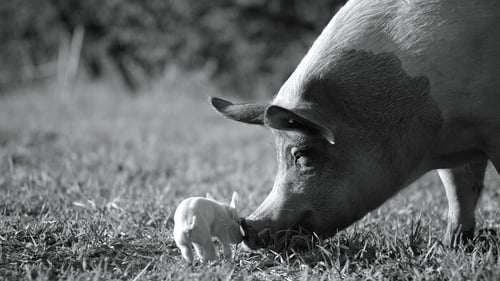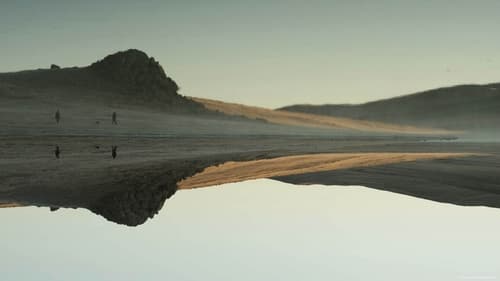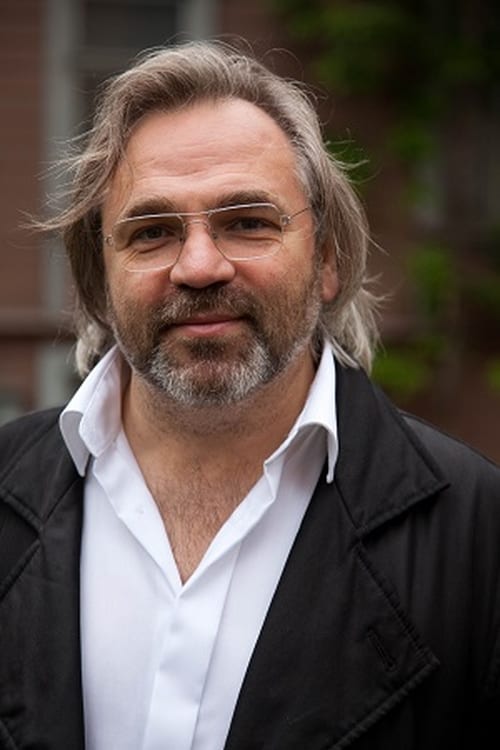
Editor
Мы делим нашу планету с миллиардами других животных. Через встречи со свиноматкой Гундой, двумя коровами и курицей мы можем задуматься о врожденной ценности жизни и тайне всего животного сознания, в том числе и нашего собственного.

Director of Photography
Мы делим нашу планету с миллиардами других животных. Через встречи со свиноматкой Гундой, двумя коровами и курицей мы можем задуматься о врожденной ценности жизни и тайне всего животного сознания, в том числе и нашего собственного.

Screenplay
Мы делим нашу планету с миллиардами других животных. Через встречи со свиноматкой Гундой, двумя коровами и курицей мы можем задуматься о врожденной ценности жизни и тайне всего животного сознания, в том числе и нашего собственного.

Director
Мы делим нашу планету с миллиардами других животных. Через встречи со свиноматкой Гундой, двумя коровами и курицей мы можем задуматься о врожденной ценности жизни и тайне всего животного сознания, в том числе и нашего собственного.

Writer
«Акварель» погружает зрителя в высокохудожественное кинопутешествие сквозь преображающуюся красоту и мощь воды. Снятый на суперсовременном оборудовании, со скоростью 96 кадров в секунду, этот фильм является глубоким откровением о том, что люди не достойны чистоты и постоянно изменяющейся энергии самого драгоценного сокровища планеты Земля. От замерзшего озера Байкал до Майами, терзаемого ураганом Ирма, до водопада Анхель в Венесуэле, вода – главный герой фильма «Акварель», поражающего наше воображение художественными приемами и визуальными подробностями.

Editor
«Акварель» погружает зрителя в высокохудожественное кинопутешествие сквозь преображающуюся красоту и мощь воды. Снятый на суперсовременном оборудовании, со скоростью 96 кадров в секунду, этот фильм является глубоким откровением о том, что люди не достойны чистоты и постоянно изменяющейся энергии самого драгоценного сокровища планеты Земля. От замерзшего озера Байкал до Майами, терзаемого ураганом Ирма, до водопада Анхель в Венесуэле, вода – главный герой фильма «Акварель», поражающего наше воображение художественными приемами и визуальными подробностями.

Director of Photography
«Акварель» погружает зрителя в высокохудожественное кинопутешествие сквозь преображающуюся красоту и мощь воды. Снятый на суперсовременном оборудовании, со скоростью 96 кадров в секунду, этот фильм является глубоким откровением о том, что люди не достойны чистоты и постоянно изменяющейся энергии самого драгоценного сокровища планеты Земля. От замерзшего озера Байкал до Майами, терзаемого ураганом Ирма, до водопада Анхель в Венесуэле, вода – главный герой фильма «Акварель», поражающего наше воображение художественными приемами и визуальными подробностями.

Director
«Акварель» погружает зрителя в высокохудожественное кинопутешествие сквозь преображающуюся красоту и мощь воды. Снятый на суперсовременном оборудовании, со скоростью 96 кадров в секунду, этот фильм является глубоким откровением о том, что люди не достойны чистоты и постоянно изменяющейся энергии самого драгоценного сокровища планеты Земля. От замерзшего озера Байкал до Майами, терзаемого ураганом Ирма, до водопада Анхель в Венесуэле, вода – главный герой фильма «Акварель», поражающего наше воображение художественными приемами и визуальными подробностями.

Editor
A 3-year-old girl and her family's long journey from a Greek refugee centre to Uppsala.

Director

Director of Photography
Seven-year-old Polina and her 13-year-old sister Nastia live and breathe ballet. Both of them are studying at the Boris Eifman Dance Academy in frigid Saint Petersburg. They’re currently awaiting their grades to find out if they’ve done well enough to be promoted to the next year, with Nastia lovingly guiding he little sister through the process. But in the meantime, Nastia also has to deal with the high demands that the academy places on its students. The gorgeously styled shots are sometimes calm, even clinical, and sometimes warm, lively and funny.

Director
Seven-year-old Polina and her 13-year-old sister Nastia live and breathe ballet. Both of them are studying at the Boris Eifman Dance Academy in frigid Saint Petersburg. They’re currently awaiting their grades to find out if they’ve done well enough to be promoted to the next year, with Nastia lovingly guiding he little sister through the process. But in the meantime, Nastia also has to deal with the high demands that the academy places on its students. The gorgeously styled shots are sometimes calm, even clinical, and sometimes warm, lively and funny.

Director
Football seen through the eyes of some of the best directors of the world.

Writer
The filmmaker Victor Kossakovsky on homeless people sleeping near A.T.M.’s in a bank, a growing phenomenon in Europe.

Director
The filmmaker Victor Kossakovsky on homeless people sleeping near A.T.M.’s in a bank, a growing phenomenon in Europe.

Himself
In his film, the Chilean film director accompanies Russian filmmaker Victor Kossakovsky during the shooting of his latest film. In Patagonia, at Lake Baikal and in Shanghai, Victor Kossakovsky explores the singular relationships between places and people on opposite sides of the world. Carlos Klein documents the making of this ambitious film in a very personal way, driven by his own inner search for images that still have an impact on us. While doing so, he reveals his own and Kossakovsky‘s ambiguous attitude towards filmmaking.

Director of Photography
What would be the shortest route between Entre Rios in Argentina and the Chinese metropolis Shanghai? Simply a straight line through the center of the earth, since the two places are antipodes: they are located diametrically opposite to each other on the earth's surface. During his visits to four such antipodal pairs, the award-winning documentary filmmaker Victor Kossakovsky captured images that turn our view of the world upside down.

Editor
What would be the shortest route between Entre Rios in Argentina and the Chinese metropolis Shanghai? Simply a straight line through the center of the earth, since the two places are antipodes: they are located diametrically opposite to each other on the earth's surface. During his visits to four such antipodal pairs, the award-winning documentary filmmaker Victor Kossakovsky captured images that turn our view of the world upside down.

Director
What would be the shortest route between Entre Rios in Argentina and the Chinese metropolis Shanghai? Simply a straight line through the center of the earth, since the two places are antipodes: they are located diametrically opposite to each other on the earth's surface. During his visits to four such antipodal pairs, the award-winning documentary filmmaker Victor Kossakovsky captured images that turn our view of the world upside down.

Director of Photography
In Russian, "Svyato" means "happy". But it is also a nickname for Svyatoslav, the son of director Kossakovsky, who for two years covered mirrors from Svyato. For the first time in his life, Svyato is going to watch himself on a mirror.

Script
In Russian, "Svyato" means "happy". But it is also a nickname for Svyatoslav, the son of director Kossakovsky, who for two years covered mirrors from Svyato. For the first time in his life, Svyato is going to watch himself on a mirror.

Director
In Russian, "Svyato" means "happy". But it is also a nickname for Svyatoslav, the son of director Kossakovsky, who for two years covered mirrors from Svyato. For the first time in his life, Svyato is going to watch himself on a mirror.

Director of Photography
Документальная комедия том, что происходит в мире – за окном квартиры автора в более-менее историческом районе Петербурга. Фильм снят открытой камерой из открытого окна в год подготовки к празднованию 300-летия города.

Editor
Документальная комедия том, что происходит в мире – за окном квартиры автора в более-менее историческом районе Петербурга. Фильм снят открытой камерой из открытого окна в год подготовки к празднованию 300-летия города.

Producer
Документальная комедия том, что происходит в мире – за окном квартиры автора в более-менее историческом районе Петербурга. Фильм снят открытой камерой из открытого окна в год подготовки к празднованию 300-летия города.

Writer
Документальная комедия том, что происходит в мире – за окном квартиры автора в более-менее историческом районе Петербурга. Фильм снят открытой камерой из открытого окна в год подготовки к празднованию 300-летия города.

Director
Документальная комедия том, что происходит в мире – за окном квартиры автора в более-менее историческом районе Петербурга. Фильм снят открытой камерой из открытого окна в год подготовки к празднованию 300-летия города.

Director
The toddlers in a Russian playgroup are showing a striking number of adult traits. Here and there, serious romantic relationships are budding, and some tots are determined to marry. One infant may urge her friend to keep his voice low, or else the filmmakers will hear everything they say, but most pre-schoolers are undisturbed and continue their everyday activities. They play with dolls, hang around on the playground and chatter a lot, particularly about who is whose friend and who is whose lover. In this environment, the direct cinema style seems even more natural than it usually is. Two years ago, IDFA screened Victor Kossakovsky’s film Pavel and Lyalya (a Jerusalem Romance), which dealt with the profound and unselfish love of an elderly couple. In contrast, the infatuations of young kids are volatile and playful, because ten minutes later you can be married to someone else.

Editor
Trilogy about love, experienced at different moments in life, by different people: an old couple, a young couple and two children at infant school.

Cinematography
Trilogy about love, experienced at different moments in life, by different people: an old couple, a young couple and two children at infant school.

Producer
Trilogy about love, experienced at different moments in life, by different people: an old couple, a young couple and two children at infant school.

Director
Trilogy about love, experienced at different moments in life, by different people: an old couple, a young couple and two children at infant school.

Screenplay
“Like the right and left hand Your soul is close to my soul We are sealed shut, blissfully and warmly, Like the right and left wing…” The life and art of Pavel Kogan and Lyudmila Stanukinas, two famous Leningrad documentary filmmakers, can best be expressed by the Tsvetaeva stanza cited above. They are the main characters of this film, which their student Viktor Kossakovsky shot during Pavel Kogan’s final months. For Lyudmila Stanukinas, Lyalya, as those close to her called her, her husband was her only reason for existence. She was with him until the end and held onto his extinguishing life as much as she could.

Director
“Like the right and left hand Your soul is close to my soul We are sealed shut, blissfully and warmly, Like the right and left wing…” The life and art of Pavel Kogan and Lyudmila Stanukinas, two famous Leningrad documentary filmmakers, can best be expressed by the Tsvetaeva stanza cited above. They are the main characters of this film, which their student Viktor Kossakovsky shot during Pavel Kogan’s final months. For Lyudmila Stanukinas, Lyalya, as those close to her called her, her husband was her only reason for existence. She was with him until the end and held onto his extinguishing life as much as she could.

Director
Victor Kossakovsky searched obsessively for inhabitants of St. Petersburg who were born on Wednesday 19 July 1961, his own birthday, in former Leningrad. Fifty-one women and fifty men fitted the profile. In the course of time a few of these 101 people had died, others had moved to another community or abroad. But in 1995 Kossakovsky managed to capture on film all seventy remaining residents, in the street, at work or simply at home. While doing so he spent time with doctors and patients, entertainers and businessmen, construction workers and homeless people. In his unorthodox style Kossakovsky has produced a beautiful profile of people in their thirties in St. Petersburg.

Writer
Portrait of a troubled peasant family. The film tells the story of two times widow Anna Belova who lives together with her brother Mikhail. Blending the two personalities, Kosakovsky characterizes the true Russian soul: she is the rational worker, honest and strong - he is the drunken poet, the idealist, his philosophy fades into radical nonsense time after time.

Director
Portrait of a troubled peasant family. The film tells the story of two times widow Anna Belova who lives together with her brother Mikhail. Blending the two personalities, Kosakovsky characterizes the true Russian soul: she is the rational worker, honest and strong - he is the drunken poet, the idealist, his philosophy fades into radical nonsense time after time.

Director of Photography
It was one of his mentors who once told Kossakovsky, "There are two types of intelligent people; some say what they know, while others think while they speak, in order to try and say something they did not know yet, something that suggests itself in them." Victor Kossakovsky took this profundity to heart and became a filmmaker of the second category. He dedicated his documentary debut to the speaker of these words, the Russian philosopher and religious thinker Alexey Fedorovich Losev (1893-1988), who died shortly after the completion of this film. Shot in black-and-white, the film consists of two crucial shots that symbolize silence and night at both ends of the life chain. In the beginning of the film, the rising sun slowly swathes a cemetery in daylight. At the end, the earth covers a coffin bit by bit and heralds the great darkness. In Losev's words, "Divine intentions that lie beyond our reason, that's why we die."

Editor
It was one of his mentors who once told Kossakovsky, "There are two types of intelligent people; some say what they know, while others think while they speak, in order to try and say something they did not know yet, something that suggests itself in them." Victor Kossakovsky took this profundity to heart and became a filmmaker of the second category. He dedicated his documentary debut to the speaker of these words, the Russian philosopher and religious thinker Alexey Fedorovich Losev (1893-1988), who died shortly after the completion of this film. Shot in black-and-white, the film consists of two crucial shots that symbolize silence and night at both ends of the life chain. In the beginning of the film, the rising sun slowly swathes a cemetery in daylight. At the end, the earth covers a coffin bit by bit and heralds the great darkness. In Losev's words, "Divine intentions that lie beyond our reason, that's why we die."

Screenplay
It was one of his mentors who once told Kossakovsky, "There are two types of intelligent people; some say what they know, while others think while they speak, in order to try and say something they did not know yet, something that suggests itself in them." Victor Kossakovsky took this profundity to heart and became a filmmaker of the second category. He dedicated his documentary debut to the speaker of these words, the Russian philosopher and religious thinker Alexey Fedorovich Losev (1893-1988), who died shortly after the completion of this film. Shot in black-and-white, the film consists of two crucial shots that symbolize silence and night at both ends of the life chain. In the beginning of the film, the rising sun slowly swathes a cemetery in daylight. At the end, the earth covers a coffin bit by bit and heralds the great darkness. In Losev's words, "Divine intentions that lie beyond our reason, that's why we die."

Director
It was one of his mentors who once told Kossakovsky, "There are two types of intelligent people; some say what they know, while others think while they speak, in order to try and say something they did not know yet, something that suggests itself in them." Victor Kossakovsky took this profundity to heart and became a filmmaker of the second category. He dedicated his documentary debut to the speaker of these words, the Russian philosopher and religious thinker Alexey Fedorovich Losev (1893-1988), who died shortly after the completion of this film. Shot in black-and-white, the film consists of two crucial shots that symbolize silence and night at both ends of the life chain. In the beginning of the film, the rising sun slowly swathes a cemetery in daylight. At the end, the earth covers a coffin bit by bit and heralds the great darkness. In Losev's words, "Divine intentions that lie beyond our reason, that's why we die."

Cinematography
Документальный фильм о городе Боровичи, Новгородская область

Director
Director Victor Kossakovsky dedicated his documentary debut to the Russian philosopher and religious thinker Alexey Fedorovich Losev (1893-1988), who died shortly after the completion of the film.

Director
Remarkable footage of a Barcelona anti-austerity demonstration – and its quelling – shaped into a lyrical tribute to the spirit of protest by Victor Kossakovsky ( ¡Vivan las Antipodas!) and 32 Spanish film students.







